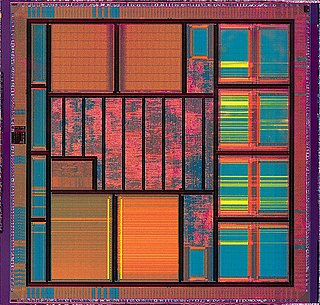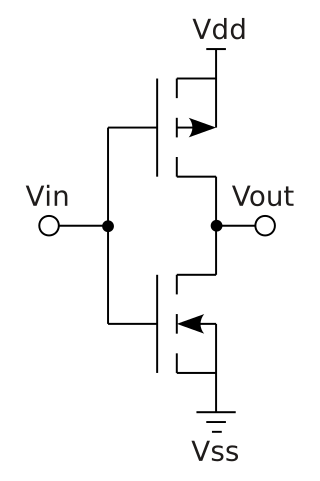Related Research Articles

An integrated circuit is a set of electronic circuits on one small flat piece of semiconductor material, usually silicon. Large numbers of miniaturized transistors and other electronic components are integrated together on the chip. This results in circuits that are orders of magnitude smaller, faster, and less expensive than those constructed of discrete components, allowing a large transistor count.

Very-large-scale integration (VLSI) is the process of creating an integrated circuit (IC) by combining millions or billions of MOS transistors onto a single chip. VLSI began in the 1970s when MOS integrated circuit chips were developed and then widely adopted, enabling complex semiconductor and telecommunication technologies. The microprocessor and memory chips are VLSI devices.

Complementary metal–oxide–semiconductor is a type of metal–oxide–semiconductor field-effect transistor (MOSFET) fabrication process that uses complementary and symmetrical pairs of p-type and n-type MOSFETs for logic functions. CMOS technology is used for constructing integrated circuit (IC) chips, including microprocessors, microcontrollers, memory chips, and other digital logic circuits. CMOS technology is also used for analog circuits such as image sensors, data converters, RF circuits, and highly integrated transceivers for many types of communication.

A mixed-signal integrated circuit is any integrated circuit that has both analog circuits and digital circuits on a single semiconductor die. Their usage has grown dramatically with the increased use of cell phones, telecommunications, portable electronics, and automobiles with electronics and digital sensors.

WaveLAN was a brand name for a family of wireless networking technology sold by NCR, AT&T, Lucent Technologies, and Agere Systems as well as being sold by other companies under OEM agreements. The WaveLAN name debuted on the market in 1990 and was in use until 2000, when Agere Systems renamed their products to ORiNOCO. WaveLAN laid the important foundation for the formation of IEEE 802.11 working group and the resultant creation of Wi-Fi.
The asynchronous array of simple processors (AsAP) architecture comprises a 2-D array of reduced complexity programmable processors with small scratchpad memories interconnected by a reconfigurable mesh network. AsAP was developed by researchers in the VLSI Computation Laboratory (VCL) at the University of California, Davis and achieves high performance and energy-efficiency, while using a relatively small circuit area. It was made in 2006.
The Mead–Conway VLSI chip design revolution, or Mead and Conway revolution, was a very-large-scale integration (VLSI) design revolution starting in 1978 which resulted in a worldwide restructuring of academic materials in computer science and electrical engineering education, and was paramount for the development of industries based on the application of microelectronics.

Asad Ali Abidi is a Pakistani-American electrical engineer. He serves as a tenured professor at University of California, Los Angeles, and is the inaugural holder of the Abdus Salam Chair at the Lahore University of Management Sciences (LUMS). He is best known for pioneering RF CMOS technology during the late 1980s to early 1990s. As of 2008, the radio transceivers in all wireless networking devices and modern mobile phones are mass-produced as RF CMOS devices.
Kamran Eshraghian is an electronics engineer notable for working on VLSI in Australia. He has worked on CMOS VLSI design.
In semiconductor manufacturing, a process corner is an example of a design-of-experiments (DoE) technique that refers to a variation of fabrication parameters used in applying an integrated circuit design to a semiconductor wafer. Process corners represent the extremes of these parameter variations within which a circuit that has been etched onto the wafer must function correctly. A circuit running on devices fabricated at these process corners may run slower or faster than specified and at lower or higher temperatures and voltages, but if the circuit does not function at all at any of these process extremes the design is considered to have inadequate design margin.
Daniel "Dan" William Dobberpuhl was an electrical engineer in the United States who led several teams of microprocessor designers.
In electronics, pass transistor logic (PTL) describes several logic families used in the design of integrated circuits. It reduces the count of transistors used to make different logic gates, by eliminating redundant transistors. Transistors are used as switches to pass logic levels between nodes of a circuit, instead of as switches connected directly to supply voltages. This reduces the number of active devices, but has the disadvantage that the difference of the voltage between high and low logic levels decreases at each stage. Each transistor in series is less saturated at its output than at its input. If several devices are chained in series in a logic path, a conventionally constructed gate may be required to restore the signal voltage to the full value. By contrast, conventional CMOS logic switches transistors so the output connects to one of the power supply rails, so logic voltage levels in a sequential chain do not decrease. Simulation of circuits may be required to ensure adequate performance.

Ian A. Young is an Intel engineer. Young is a co-author of 50 research papers, and has 71 patents in switched capacitor circuits, DRAM, SRAM, BiCMOS, x86 clocking, Photonics and spintronics.
David Skellern is an Australian electronic engineer and computer scientist credited, along with colleagues, for the first chip-set implementation of the IEEE 802.11a wireless networking standard.

Eby G. Friedman is an electrical engineer, and Distinguished Professor of Electrical and Computer Engineering at the University of Rochester. Friedman is also a visiting professor at the Technion - Israel Institute of Technology. He is a Senior Fulbright Fellow and a Fellow of the IEEE.

Payam Heydari is an Iranian-American Professor who is noted for his contribution to the field of radio-frequency and millimeter-wave integrated circuits.
sCMOS are a type of CMOS image sensor (CIS). These sensors are commonly used as components in specific observational scientific instruments, such as microscopes and telescopes. sCMOS image sensors offer extremely low noise, rapid frame rates, wide dynamic range, high quantum efficiency, high resolution, and a large field of view simultaneously in one image.
RF CMOS is a metal–oxide–semiconductor (MOS) integrated circuit (IC) technology that integrates radio-frequency (RF), analog and digital electronics on a mixed-signal CMOS RF circuit chip. It is widely used in modern wireless telecommunications, such as cellular networks, Bluetooth, Wi-Fi, GPS receivers, broadcasting, vehicular communication systems, and the radio transceivers in all modern mobile phones and wireless networking devices. RF CMOS technology was pioneered by Pakistani engineer Asad Ali Abidi at UCLA during the late 1980s to early 1990s, and helped bring about the wireless revolution with the introduction of digital signal processing in wireless communications. The development and design of RF CMOS devices was enabled by van der Ziel's FET RF noise model, which was published in the early 1960s and remained largely forgotten until the 1990s.
References
- ↑ https://www.adelaide.edu.au/records/archives/former/Neil_Weste.pdf [ dead link ]
- ↑ "Emotiv Emerges from Stealth to Revolutionize Human Computer Interaction" (PDF). Archived from the original (PDF) on 21 July 2008. Retrieved 13 July 2008.
- ↑ Nicholls, Mike (30 October 2017). "Morse Micro & Main Sequence Ventures". Main Sequence Ventures. Retrieved 6 December 2017.
- ↑ Weste, Neil and Eshraghian, Kamran, Principles of CMOS VLSI Design - A Systems Perspective, Addison-Wesley, MA, 1985
- ↑ Weste, Neil and Eshraghian, Kamran, Principles of CMOS VLSI Design - A Systems Perspective, 2nd Edition Addison-Wesley, MA, 1993
- ↑ Weste, Neil and Harris, David, Principles of CMOS VLSI Design - A Circuits and Systems Perspective, 3rd Edition Addison-Wesley, MA, May 2004
- ↑ Weste, Neil and Harris, David, Principles of CMOS VLSI Design - A Circuits and Systems Perspective, 4th Edition Addison-Wesley, MA, 2010
- ↑ "IEEE - Fellow Class of 1996". Institute of Electrical and Electronics Engineers (IEEE). Archived from the original on 20 April 2010. Retrieved 11 July 2010.